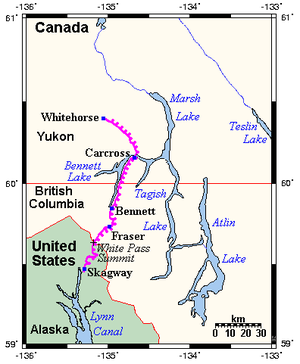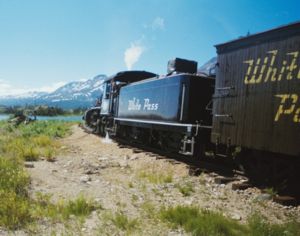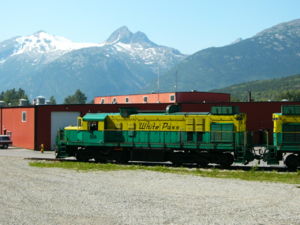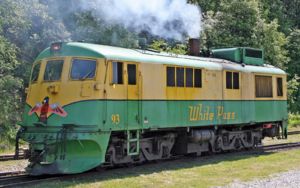White Pass and Yukon Route
| White Pass and Yukon Route | |
|---|---|
| logo | |
| Reporting marks | WPY |
| Locale | Alaska, northern British Columbia, Yukon Territory |
| Dates of operation | 1898–1982, 1988 – present |
| Track gauge | 3 ft (914 mm) |
| Headquarters | Skagway, Alaska |
The White Pass and Yukon Route (WP&Y, WP&YR) (AAR reporting marks WPY) is a narrow gauge railroad linking the port of Skagway, Alaska with Whitehorse, the capital of Canada's Yukon Territory. An isolated system, it has no connection to any other railroad. The railroad is operated by the Pacific and Arctic Railway and Navigation Company (in Alaska), the British Columbia Yukon Railway Company (in British Columbia) and the British Yukon Railway Company, originally known as the British Yukon Mining, Trading and Transportation Company (in Yukon Territory), which use the trade name White Pass and Yukon Route.
Contents
Construction
The line was born of the Klondike Gold Rush of 1897. The most popular route taken by prospectors to the gold fields in Dawson City was a treacherous route from the nearest port in Skagway or Dyea, Alaska across the mountains to the Canadian border at the summit of the Chilkoot Pass or the White Pass. There, the prospectors would not be allowed across by the Canadian authorities unless they had a full ton of supplies with them. There was a need for a better transportation scheme than the pack horses used over the White Pass or people's backs over the Chilkoot Pass. This need generated numerous railroad schemes. In 1897, the Canadian government received 32 proposals for Yukon railroads, most of which were never realized.
In 1897, three separate companies were organized to build a rail link from Skagway to Fort Selkirk, Yukon, 325 miles (523 km) away. Largely financed by British investors, a railroad was soon under construction. A 3 foot (914 mm) gauge was chosen; the narrower roadbed required by a narrow gauge railroad made for big cost savings when that roadbed had to be carved and blasted out of the mountain rock. Even so, 450 tons of explosives were used to reach White Pass summit. The narrow gauge also allowed for a tighter radius to be used on curves, making the task easier by allowing the railroad to follow the landscape more, rather than having to be blasted through it.
Construction started in May 1898, but they ran into some roadblocks in dealing with the local city government and the town's crime boss, Soapy Smith. The President, Samuel Graves, was elected as chairman of the vigilante organization that was trying to expel Soapy and his gang of confidence men and rogues. On the evening of July 8, 1898, Soapy Smith was killed in a gunfight with the guards at one of the vigilante's meetings. Samuel Graves witnessed the shooting. The railroad helped block off the escape routes of the gang, aiding in their capture, and the remaining roadblocks in Skagway subsided. On July 21, 1898, an excursion train hauled passengers for four miles (6.4 km) out of Skagway, the first train to operate in Alaska. On July 30, 1898, the charter rights and concessions of the three companies were acquired by the White Pass & Yukon Railway Company Limited, a new company organized in London. Construction reached the 2,885-foot (879.35 m) summit of White Pass, 20 miles (32.2 km) away from Skagway, by mid-February 1899. The railway reached Bennett, British Columbia on July 6, 1899. In the summer of 1899, construction started north from Carcross to Whitehorse, 110 miles (177 km) north of Skagway. The construction crews working from Bennett along a difficult lakeshore reached Carcross the next year, and the last spike was driven on July 29, 1900, with service starting on August 1, 1900. However, by then, much of the Gold Rush fever had died down.
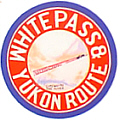
Operations before World War II
However, serious professional mining was taking its place; not so much for gold as for other metals such as copper, silver and lead. The closest port was Skagway, the only route there was via the White Pass & Yukon Route's river boats and railroad.
While ores and concentrates formed the bulk of the traffic, the railroad also carried passenger traffic, and other freight. There was, for a long time, no easier way into the Yukon Territory, and no other way into or out of Skagway except by sea.
Financing and route was in place to extend the rails from Whitehorse to Carmacks, but there was chaos in the river transportation service, resulting in a bottleneck. The White Pass instead used the money to purchase most of the riverboats, providing a steady and reliable transportation system between Whitehorse and Dawson City.
While the WP&YR never built between Whitehorse and Fort Selkirk, some minor expansion of the railway occurred after 1900. In 1901, the Taku Tram, a 2½-mile (4 km) portage railroad was built at Taku City, British Columbia, which was operated until 1951. It carried passengers and freight between the S.S. Tutshi operating on Tagish Lake and the M.V. Tarahne operating across Atlin Lake to Atlin, British Columbia. (While the Tutshi was destroyed by a suspicious fire around 1990, the Tarahne was restored and hosts special dinners including murder mysteries. Lifeboats built for the Tutshi's restoration were donated to the Tarahne.) The Taku Tram could not even turn around, and simply backed up on its westbound run. The locomotive used, the Duchess, is now in Carcross.
In 1910, the WP&YR operated a branch line to Pueblo, a mining area near Whitehorse. This branch line was abandoned in 1918; a haul-road follows that course today but is mostly barricaded; a Whitehorse Star editorial in the 1980s noted that this route would be an ideal alignment if the Alaska Highway should ever require a bypass reroute around Whitehorse.
While all other railroads in the Yukon (such as the Klondike Mines Railroad at Dawson City) had been abandoned by 1914, the WP&YR continued to operate.
During the Great Depression, traffic was sparse on the WP&YR, and for a time trains operated as infrequently as once a week.
World War II
With the outbreak of World War II, things took a distinct turn for the busier. Alaska became of strategic importance for the United States; there was much worry that the Japanese might invade it, as the nearest part of the United States to Japan. The US Army took control, bringing some newly built and many used steam locomotives (such as the USATC S118 Class) brought from closed US narrow gauge lines to the railroad.
There are two persistent myths that show up in almost every book or article which mentions the role of the White Pass & Yukon Route in the building of the Alcan Highway during the Second World War. The myths concern the eleven new 2-8-2 MacArthur type locomotives that the US Army brought to the WP&YR in 1943. Myth #1 is that they were converted from meter gauge to 3 foot gauge by the WP&YR shops in Skagway Alaska. Myth #2 is that they were built for Iran and diverted to the WP&YR. Neither myth is true.
These locomotives, designated USA 190 to USA 200, were constructed by Baldwin Locomotive Works as 36" gauge and shipped fully assembled. No modification was needed. The MacArthur was designed by the American Locomotive Company for 42" gauge and the smaller gauges were cleverly accommodated with various sized spacers in strategic locations and different length axles. In total, nearly 800 MacArthurs were produced by ALCO, Baldwin, and a few other manufacturers.
The reason USA 190-200 were never destined for "Iran" as it's often mistakenly stated in books relating WP&YR history, is that Iran's government railway was standard gauge. Also, because of scarce water and extensive tunnels, Iran was the first case where the Army primarily used diesel locomotives. USATC narrow gauge locomotives were never destined for Iran.
The first locomotives of the MacArthur design that Baldwin Locomotive Works built were USA 190-200 for the WP&YR, which makes them somewhat unique. This initial 1942 sales order to Baldwin for 60 MacArthur meter gauge [39 3/8"] locomotives was for India's extensive meter gauge railway system. The first eleven were diverted to the WP&YR as 36", the next 15 went to India as meter gauge, another 20 went to Queensland Ry as 42", and the remaining 14 were meter gauge for India where the order was destined before the Alaskan and Australian diversions. Therefore if the WP&YR MacArthurs were diverted from anywhere it would have been India, not Iran.
from: (http://www.whitepassfan.net/whitepass/home/html/modules.php?op=modload&name=News&file=article&sid=41&mode=thread&order=0&thold=0) sources: R. Tourret, 1995 – "Allied Military Railroads of the Second World War" Carl R. Gray, 1955 - "Railroading in Eighteen Countries"
The White Pass saw record volumes of traffic as it served as a vital supply route for construction materials for the new Alaska Highway and other projects. As many as 17 trains were operated daily. In one record period of 24 hours, 37 trains rolled into Whitehorse.
1946-1982
In 1951, the White Pass and Yukon Corporation Ltd., a new holding company, was incorporated to acquire the three railway companies comprising the WP&YR from the White Pass and Yukon Company, Ltd., which was in liquidation. The railway was financially restructured. While most other narrow gauge systems in North America were closing around this time, the WP&YR remained open.
The railroad dieselised in the mid to late 1950s, one of the few North American narrow gauge railroads to do so. The railroad bought shovelnose diesels from General Electric, and later road-switchers from American Locomotive Company (Alco) and Montreal Locomotive Works, as well as a few small switchers.
The railroad was an early pioneer of intermodal freight traffic, commonly called container; advertising of the time referred to it as the Container Route. With custom built container ships, railroad cars and truck trailers, the White Pass showed the benefits of intermodal transportation early - a single container, loaded in the Yukon territory, could be transported anywhere in the world without needing to be opened and reloaded, whether transported by road, rail, or sea. The WP&YR owned the world's first container ship (the Clifford J. Rogers, built in 1955), and in 1956 introduced containers.
The Faro lead-zinc mine opened in 1969. The railway was upgraded with seven new 1200 horsepower (890 kW) locomotives from the Alco, new freight cars, ore buckets, a "straddle carrier" at Whitehorse to transfer from the railway's new fleet of trucks, a new ore dock at Skagway, and assorted work on the rail line to improve alignment. In the fall of 1969, a new tunnel and bridge that bypassed Dead Horse Gulch were built to replace the tall steel cantilever bridge that could not carry the heavier trains. This enormous investment made the company dependent on continued ore traffic to earn the revenue, and left the railway vulnerable to loss of that ore-carrying business.
As well, passenger traffic on the WP&YR was increasing as cruise ships started to visit Alaska's Inside Passage. There was no road from Skagway to Whitehorse until 1978. Even once the road was built, the White Pass still survived on the ore traffic from the mines.
During this time, the green-yellow engine colour scheme, with a thunderbird on the front, was replaced with blue, patterned with black and white. (The green-yellow scheme was restored in the early 1990s, along with the thunderbird. As of 2005, however, one engine still has the blue colour scheme. The steam engines, however, remain basic black.)
In 1982, metal prices plunged, striking with devastating effect on the mines that were the White Pass and Yukon Route's main customers. Many, including the Faro lead-zinc mine, closed down, and with that traffic gone, the White Pass was doomed as a commercial railroad. Hopeful of a reopening, the railway ran at a significant loss for several months, carrying only passengers. However, the railway closed down on October 7, 1982.
The Northwestel telephone directory issued May 1, 1982 for Yukon and Northern British Columbia, carried on its cover a photograph of a White Pass train traveling south through Bennett, an irony as the trains were no longer running for more than half the time the directory was in use.
Some of the road's Alco diesels were sold to a railroad in Colombia, and the newer Alco diesels on order with Alco's Canadian licensee MLW (Montreal Locomotive Works) were sold to US Gypsum in Plaster City, California. Only one of these modern narrow gauge diesels, the last narrow gauge diesel locomotives built for a North American customer, was delivered to the White Pass. The five diesels sold to Colombia were not used as they were too heavy, and were re-acquired in 1999 - one was nearly lost at sea during a storm as it broke loose on the barge and slowly rolled over the edge.
Revival, 1988-present
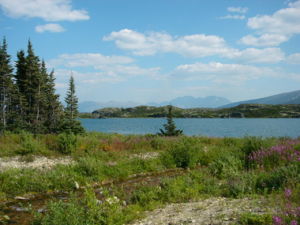
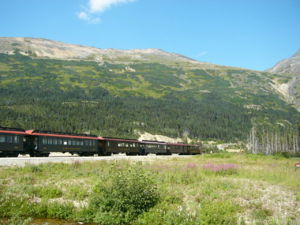
The shutdown, however, was not for long. Tourism to Alaska began to increase, with many cruise ships stopping at Skagway. The dramatic scenery of the White Pass' route sounded like a great tourist draw; and the rails of the White Pass & Yukon Route were laid right down to the docks, even along them, for the former freight and cruise ship traffic. Cruise operators, remembering the attraction of the little mountain climbing trains to their passengers, pushed for a re-opening of the line as a heritage railway. The White Pass was and is perfectly positioned to sell a railroad ride through the mountains to cruise ship tourists; they don't even have to walk far.
Following a deal between White Pass and the United Transportation Union representing Alaska employees of the road, the White Pass Route was reopened between Skagway and White Pass in 1988 purely for tourist passenger traffic. The White Pass Route also bid on the ore-haul from the newly reopened Faro mine, but its price was considerably higher than road haulage over the Klondike Highway.
The railway still uses vintage parlor cars, the oldest built in 1883 and predating WP&YR by 15 years, and eight new cars built in 2005 follow the same 19th century design. At least three cars have wheelchair lifts.
A work train actually reached Whitehorse in late August, 1988, its intent being to haul two locomotives, parked in Whitehorse for six years, to Skagway to be overhauled and used on the tourist trains. While in Whitehorse for approximately one week, it hauled the parked rolling stock - flatcars, tankers and a caboose - out of the downtown area's sidings, and the following year, they were hauled further south, many eventually sold. Most of the tracks in downtown Whitehorse have now been torn up, and the line's terminus is six city blocks south of the old train depot at First Avenue and Main Street. A single new track along the waterfront enables the operation, by a local historical society, of a tram for tourist purposes.
After customs and Canadian labour union jurisdictional issues were resolved, the WP&YR main line reopened to Fraser in 1989, and Bennett in 1992. A train reached Carcross in 1997 to participate in the Ton of Gold centennial celebration. A special passenger run, by invitation only, was made from Carcross to Whitehorse on October 10, 1997, and there are plans to eventually re-open the entire line to Whitehorse if a market exists. So far, the tracks are only certified to Carcross by the Canadian Transportation Agency; on July 29, 2006, White Pass ran a train to Carcross and announced passenger service to begin in May 2007, six trains per week, with motorcoach return trips.
WP&YR acquired some rolling stock from CN's Newfoundland operations, which shut down in November, 1988; the acquisition definitely included gravel cars, still painted in CN orange; it is uncertain if, as reported in 1989, some passenger cars such as dining cars were also acquired; since WP&YR does not use dining cars, they would have been converted to parlor cars in vintage design.
Most trains are hauled by the line's diesel locomotives, attractively painted in green (lower) and yellow (upper), but one of the line's original steam locomotives is still in operation too, #73, a 2-8-2 Mikado-type locomotive. Another steam locomotive, #40 a 2-8-0 Consolidation type locomotive was on loan from the Georgetown Loop railroad in Colorado for upwards of 5 years, but was returned after only 2 years. Former WP&Y 69, a 2-8-0 has been acquired, rebuilt and is expected to be in use in 2006.
Also operational, a few times a year, is an original steam-powered rotary snowplow, an essential device in the line's commercial service days. While it is not needed as the tourist season is only in the summer months, it is a spectacle in operation, though, and the White Pass runs the steam plow for railfan groups once or twice a winter, pushed by two diesel locomotives (in 2000 only, it was pushed by two steam locomotives, #73 and #40).
The centennial of the Golden Spike at Carcross was reenacted on July 29, 2000, complete with two steam engines meeting nose-to-nose (#73 and #40), and a gold-coated steel spike being driven by a descendant of WP&YR contractor Michael Heney.
One organization chartered a steam-pulled train from Carcross to Fraser, with a stopover at Bennett, on Friday, June 24, 2005. When expected participants seemed unlikely to arrive in the planned numbers, surplus seats were sold to the public, 120 USD or 156 CAD, with bus return to Carcross from Fraser. This represents the first paid passenger trips out of Carcross since 1982, a feature that will be regular starting in 2007.
White Pass president Gary Danielsen advised a CBC Radio interviewer that service to Whitehorse would require an enormous capital investment to restore the tracks, but the company is willing if there is either a passenger or freight potential to make it cost effective.
A June 2006 report on connecting Alaska to the continental railroad network suggested Carmacks as a hub, with a branch line to Whitehorse and beyond to either Skagway or Haines.
In addition to the restoration of the actual rail line, several former White Pass steam locomotives are currently in operation at tourist attractions in the Southeastern United States. Locomotives 70, 71, and 192 are at the Dollywood theme park in Pigeon Forge, Tennessee. Locomotive 190 is at Tweetsie Railroad in Boone, North Carolina.
Accidents
A serious derailment on September 3, 2006, resulted in the death of one section worker. A work train, Engine 114 pulling eight gravel cars, derailed approximately three miles (4.8 km) south of Bennett, injuring all four train crew, two Canadian and two American; one died at the scene; the others were airlifted to hospital and are stable; the engine remains on its side at the scene. Passenger operations on the blocked section had ended for the season just before the accident.
Video
The return of Rotary #1 - a steam rotary unit
References
- Lavallée, Omer (1972). Narrow Gauge Railways of Canada. Montreal: Railfare Enterprises Limited, pages 56–63,107–111. ISBN 0-919130-21-6.
See also
External links
| Passenger railways of Canada | |
|---|---|
| Metro systems | Montreal Metro • Toronto subway/RT • Vancouver SkyTrain |
| Light rail | C-Train (Calgary) • Edmonton Light Rail • O-Train (Ottawa) • Toronto streetcars • Toronto Pearson Airport People Mover |
| Long distance | VIA Rail • Ontario Northland Railway • Canadian National Railway • Canadian Pacific Railway • Quebec North Shore and Labrador Railway • Tshiuetin Rail Transportation • White Pass and Yukon Route |
| Commuter rail | GO Transit (Toronto) • Agence métropolitaine de transport (Montreal) • West Coast Express (Vancouver) |
